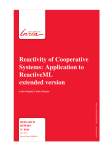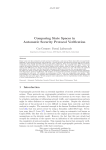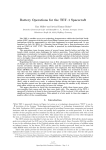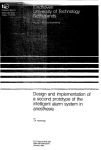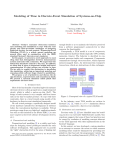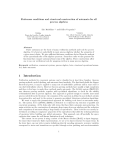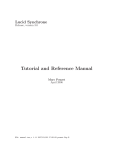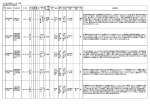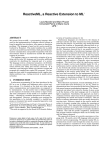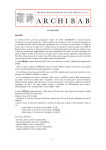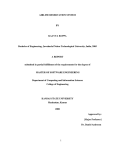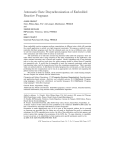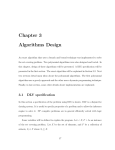Download Reactivity of Cooperative Systems
Transcript
Reactivity of Cooperative Systems
Application to ReactiveML
Louis Mandel1,3 and Cédric Pasteur2,3
1
2
Collège de France
DI École normale supérieure (now at ANSYS-Esterel Technologies)
3
INRIA Paris-Rocquencourt
Abstract. Cooperative scheduling enables efficient sequential implementations of concurrency. It is widely used to provide lightweight threads
facilities as libraries or programming constructs in many programming
languages. However, it is up to programmers to actually cooperate to
ensure the reactivity of their programs.
We present a static analysis that checks the reactivity of programs by
abstracting them into so-called behaviors using a type-and-effect system.
Our objective is to find a good compromise between the complexity of the
analysis and its precision for typical reactive programs. The simplicity of
the analysis is mandatory for the programmer to be able to understand
error messages and how to fix reactivity problems.
Our work is applied and implemented in the functional synchronous language ReactiveML. It handles recursion, higher-order processes and firstclass signals. We prove the soundness of our analysis with respect to the
big-step semantics of the language: a well-typed program with reactive
effects is reactive. The analysis is easy to implement and generic enough
to be applicable to other models of concurrency such as coroutines.
1
Introduction
Most programming languages offer lightweight thread facilities, either integrated
in the language like the asynchronous computations [30] of F#, or available as a
library like GNU Pth [12] for C, Concurrent Haskell [15] or Lwt [34] for OCaml.
These libraries are based on cooperative scheduling: each thread of execution
cooperates with the scheduler to let other threads execute. This enables an efficient and sequential implementation of concurrency, allowing to create up to
millions of separate threads, which is impossible with operating system threads.
Synchronization also comes almost for free, without requiring synchronization
primitives like locks.
The downside of cooperative scheduling is that it is necessary to make sure
that threads actually cooperate:
– Control must regularly be returned to the scheduler. This is particularly true
for infinite loops, which are very often present in reactive and interactive
systems.
– Blocking functions, like operating system primitives for I/O, cannot be called.
The solution to the latter is simple: never use blocking functions inside cooperative threads. All the facilities mentioned earlier provide either I/O libraries
compatible with cooperative scheduling or a means to safely call blocking functions. See Marlow et al. [22] for an overview on how to implement such libraries.
Dealing with the first issue is usually the responsibility of the programmer.
For instance, in the Lwt manual [11], one can find:
[...] do not write function that may take time to complete without using
Lwt [...]
The goal of this paper is to design a static analysis, called reactivity analysis,
to statically remedy this problem of absence of cooperation points. The analysis
checks that the programmer does not forget to cooperate with the scheduler.
Our work is applied to the ReactiveML language [19], which is an extension
of ML with a synchronous model of concurrency [6] (Section 2). However, we
believe that our approach is generic enough to be applied to other models of
concurrency (Section 6). The contributions of this paper are the following:
– A reactivity analysis based on a type-and-effect system [18] in Section 4. The
computed effects are called behaviors [3] and are introduced in Section 3.
They represent the temporal behaviors of processes by abstracting away
values but keeping part of the structure of the program and are used to
check if processes cooperate or not.
– A novel approach to subeffecting [23], that is, subtyping on effects, based
on row polymorphism [26] in Section 4.4. It allows to build a conservative
extension of the existing type system with little overhead.
– A proof of the soundness of the analysis (Section 4.5): a well-typed program
with reactive effects is reactive.
The paper ends with some examples (Section 5), discussion (Section 6) and
related work (Section 7). The work presented here is implemented in the ReactiveML compiler4 and it has already helped detecting many reactivity bugs. An
extended version of the paper, the implementation, the source code of the examples and an online toplevel are available at http://reactiveml.org/sas14.
2
Overview of the approach
ReactiveML extends ML with programming constructs inspired from synchronous
languages [6]. It introduces a built-in notion of parallelism where time is defined
as a succession of logical instants. Each parallel process must cooperate to let
time elapse. It is a deterministic model of concurrency that is compatible with
the dynamic creation of processes [9]. Synchrony gives us a simple definition
for reactivity: a reactive ReactiveML program is one where each logical instant
terminates.
Let us first introduce ReactiveML syntax and informal semantics using a simple program that highlights the problem of non-reactivity. Then we will discuss
the design choices and limitations of our reactivity analysis using a few other
examples.
4
http://www.reactiveml.org
2.1
A first example
We start by creating a process that emits a signal every timer seconds:5
1
2
3
4
5
6
let process clock timer s =
let time = ref (Unix.gettimeofday ()) in
loop
let time’ = Unix.gettimeofday () in
if time’ -. !time >= timer then (emit s (); time := time’)
end
In ReactiveML, there is a distinction between regular ML functions and processes, that is, functions whose execution can span several logical instants. Processes are defined using the process keyword. The clock process is parametrized
by a float timer and a signal s. Signals are communication channels between
processes, with instantaneous broadcast. The process starts by initializing a local reference time with the current time (line 2), read using the gettimeofday
function of the Unix module from the standard library. Then it enters an infinite
loop (line 3 to 6). At each iteration, it reads the new current time and emits
the unit value on the signal s if enough time has elapsed (line 5). The compiler
prints the following warning when compiling this process:
W: Line 3, characters 2-115, this expression may be an instantaneous loop
The problem is that the body of the loop is instantaneous. It means that this
process never cooperates, so that logical instants do not progress. In ReactiveML,
cooperating is done by waiting for the next instant using the pause operator. We
solve our problem by calling it at the end of the loop (line 6):
if time’ -. !time >= timer then (emit s (); time := time’);
pause
end
5
6
7
The second part of the program is a process that prints top every time
a signal s is emitted. The do/when construct executes its body only when the
signal s is present (i.e. it is emitted). It terminates by returning the value of
its body instantaneously after the termination of the body. Processes have a
consistent view of a signal’s status during an instant. It is either present or
absent and cannot change during the instant.
10
11
12
13
14
15
let process print_clock s =
loop
do
print_string "top"; print_newline ()
when s done
end
W: Line 11, characters 2-78, this expression may be an instantaneous loop
Once again, this loop can be instantaneous, but this time it depends on the
presence of the signal. While the signal s is absent, the process cooperates. When
it is present, the body of the do/when executes and terminates instantaneously.
So the body of the loop also terminates instantaneously, and a new iteration of
the loop is started in the same logical instant. Since the signal is still present,
5
The vocabulary is the one of synchronous languages, not the one of FRP.
the body of the do/when executes one more time, and so on. This process can
also be fixed by adding a pause statement in the loop.
We can then declare a local signal s and put these two processes in parallel.
The result is a program that prints top every second:
17
18
19
let process main =
signal s default () gather (fun x y -> ()) in
run (print_clock s) || run (clock 1. s)
The declaration of a signal takes as arguments the default value of the signal
and a combination function that is used to compute the value of the signal when
there are multiple emissions in a single instant. Here, the default value is () and
the signal keeps this value in case of multi-emission. The || operator represents
synchronous parallel composition. Both branches are executed at each instant
and communicate through the local signal s.
2.2
Intuitions and limitations
In the previous example, we have seen the first cause of non-reactivity: instantaneous loops. The second one is instantaneous recursive processes:
let rec process instantaneous s =
emit s (); run (instantaneous s)
W: This expression may produce an instantaneous recursion
The execution of emit is instantaneous, therefore the recursive call creates a loop
that never cooperates. A sufficient condition to ensure that a recursive process is
reactive is to have at least one instant between the instantiation of the process and
any recursive call. The idea of our analysis is to statically check this condition.
This condition is very strong and is not always satisfied by interesting reactive
programs. For instance, it does not hold for a parallel map (the let/and construct
executes its two branches in parallel, matching is instantaneous):
let rec process par_map p l =
match l with
| [] -> []
| x :: l -> let x’ = run (p x)
and l’ = run (par_map p l) in x’ :: l’
W: This expression may produce an instantaneous recursion
This process has instantaneous recursive calls, but it is reactive because the recursion is finite if the list l is finite. As the language allows to create mutable and
recursive data structures, it is hard to prove the termination of such processes.
For instance, the following expression never cooperates:
let rec l = 0 :: l in run (par_map p l)
Consequently, our analysis only prints warnings and does not reject programs.
ML functions are always considered instantaneous. So they are reactive if
and only if they terminate. Since we do not want to prove their termination,
our analysis has to distinguish recursions through functions and processes. This
allows us to assume that ML functions always terminate and to issue warnings
only for processes.
Furthermore, we do not deal with blocking functions, such as I/O primitives,
that can also make programs non-reactive. Indeed, such functions should never
be used in the context of cooperative scheduling. There are standard solutions
for this problem [22].
This analysis does not either consider the presence status of signals. It overapproximates the possible behaviors, as in the following example:
let rec process imprecise =
signal s default () gather (fun x y -> ()) in
present s then () else (* implicit pause *) ();
run imprecise
W: This expression may produce an instantaneous recursion
The present/then/else construct executes its first branch instantaneously if the
signal is present or executes the second branch with a delay of one instant
if the signal is absent. This delayed reaction to absence, first introduced by
Boussinot [9], avoids inconsistencies in the status of signals. In the example, the
signal is absent so the else branch is executed. It means that the recursion is
not instantaneous and the process is reactive. Our analysis still prints a warning,
because if the signal s could be present, the recursion would be instantaneous.
Finally, we only guarantee that the duration of each instant is finite, not that
the program is real-time, that is, that there exists a bound on this duration for
all instants, as shown in this example:
let rec process server add =
await add(p, ack) in
run (server add) || let v = run p in emit ack v
The server process listens on a signal add to receive both a process p and a signal
ack on which to send back results. As it creates one new process each time the
add signal is emitted, this program can execute an arbitrary number of processes
at the same time. It is thus not real-time, but it is indeed reactive, as waiting
for the value of a signal takes one instant (one has to collect and combine all the
values emitted during the instant).
3
The algebra of behaviors
The idea of our analysis is to abstract processes into a simpler language called
behaviors, following Amtoft et al. [3] and to check reactivity on these behaviors.
The main design choice is to completely abstract values and the presence of
signals. It is however necessary to keep an abstraction of the structure of the
program in order to have a reasonable precision.
3.1
The behaviors
The algebra of behaviors is given by:6
κ ::= • | 0 | φ | κ || κ | κ + κ | κ; κ | µφ. κ | run κ
6
Precedence of operators is the following (from highest to lowest): run, ;, +, || and
finally µ. For instance: µφ. κ1 || run κ2 + •; κ3 means µφ. (κ1 || ((run κ2 ) + (•; κ3 ))).
Actions that take at least one instant to execute, i.e. surely non-instantaneous
actions, such as pause, are denoted •. Potentially instantaneous ones, like calling a pure ML function or emitting a signal, are denoted 0. The language also
includes behavior variables φ to represent the behaviors of processes taken as
arguments, since ReactiveML has higher-order processes.
Behaviors must reflect the structure of the program, starting with parallel
composition. This is illustrated by the following example, which defines a combinator par_comb that takes as inputs two processes q1 and q2 and runs them in
parallel in a loop:
let process par_comb q1 q2 = loop (run q1 || run q2) end
The synchronous parallel composition terminates when both branches have terminated. It means that the loop is non-instantaneous if either q1 or q2 is noninstantaneous. To represent such processes, behaviors include the parallel composition, simply denoted ||. Similarly, we can define another combinator that
runs one of its two inputs depending on a condition c:
let process if_comb c q1 q2 = loop (if c then run q1 else run q2) end
In the case of if_comb, both processes must be non-instantaneous. As we want to
abstract values, we represent the different alternatives using a non-determinstic
choice operator + and forget about the conditions.
It is also necessary to have a notion of sequence, denoted ; in the language
of behaviors, as illustrated by the two following processes:
let rec process good_rec = pause; run good_rec
let rec process bad_rec = run bad_rec; pause
W: This expression may produce an instantaneous recursion
The order between the recursive call and the pause statement is crucial as the
good_rec process is reactive while bad_rec loops instantaneously. As it is defined
recursively, the behavior κ associated with the good_rec process must verify
that κ = •; run κ. The run operator is associated with running a process. This
equation can be solved by introducing an explicit recursion operator µ so that
κ = µφ. •; run φ. Recursive behaviors are defined as usual:
µφ. κ = κ[φ ← µφ. κ]
µφ. κ = κ if φ 6∈ fbv (κ)
We denote fbv (κ) the set of free behavior variables in κ. There is no operator
for representing the behavior of a loop. Indeed, a loop is just a special case of
recursion. The behavior of a loop, denoted κ∞ (where κ is the behavior of the
body of the loop), is thus defined as a recursive behavior by κ∞ , µφ. (κ; run φ).
3.2
Reactive behaviors
Using the language of behaviors, we can now characterize the behaviors that
we want to reject, that is instantaneous loops and recursions. To formally define which behaviors are reactive, we first have to define the notion of a noninstantaneous behavior, i.e. processes that take at least one instant to execute:
Definition 1 (Non-instantaneous behavior). A behavior is non-instantaneous,
denoted κ ↓, if:
•↓
φ↓
κ1 ↓
κ2 ↓
κ1 ↓
κ2 ↓
κ1 ; κ2 ↓
κ1 ; κ2 ↓
κ1 || κ2 ↓
κ1 || κ2 ↓
κ↓
κ↓
µφ. κ ↓
run κ ↓
κ1 ↓
κ2 ↓
κ1 + κ2 ↓
Note that function calls are not non-instantaneous. The fact that variables are
considered non-instantaneous means that any process taken as argument is supposed to be non-instantaneous. The reactivity is then checked when this variable
is instantiated with the actual behavior of the process.
A behavior is said to be reactive if for each recursive behavior µφ. κ, the
recursion variable φ does not appear in the first instant of the body κ. This
enforces that there must be at least one instant between the instantiation of a
process and each recursive call and is formalized in the following definition.
Definition 2 (Reactive behavior). A behavior κ is reactive if ∅ ` κ, where
the relation R ` κ is defined by:
φ 6∈ R
R`0
R ` κ1
R`•
κ1 ↓
R ` κ1
not(κ1 ↓)
R`φ
∅ ` κ2
R ` κ1 ; κ2
R ` κ1
R ` κ1 ; κ2
R ` κ2
R ` κ2
R ` κ1 || κ2
R ` κ1
R ` κ2
R ` κ1 + κ2
R ∪ {φ} ` κ
R`κ
R ` µφ. κ
R ` run κ
The predicate R ` κ means that the behavior κ is reactive with respect to the set
of variables R, that is, these variables do not appear in the first instant of κ and
all the recursions inside κ are not instantaneous. The rule for a variable φ checks
that φ is not a recursion variable introduced in the current instant. The recursion
variables are added to the set R when checking the reactivity of a recursive
behavior µφ. κ. In the case of the sequence κ1 ; κ2 , we can remove variables from R
if κ1 is non-instantaneous. One can also check from the definition of κ∞ as a
recursive behavior that this definition also implies that the body of a loop is
non-instantaneous.
3.3
Equivalence on behaviors
We can define an equivalence relation ≡ on behaviors that will be used to simplify
the behaviors. The relation is reflexive, symmetric and transitive closure of the
following rules. The operators ; and || and + are idempotent and associative.
|| and + are commutative (but not ; ). The 0 behavior (resp. •) is the neutral
element of ; and || (resp. +). The relation also satisfies the following rules (where
op is ; or || or +):
κ1 ≡ κ2
µφ. κ1 ≡ µφ. κ2
κ1 ≡ κ2
run κ1 ≡ run κ2
•∞ ≡ •
κ1 ≡ κ01
κ2 ≡ κ02
κ1 op κ2 ≡ κ01 op κ02
It is easy to show, for example, that: µφ. ((• || 0); (run φ+run φ)) ≡ µφ. (•; run φ).
An important property of this relation is that it preserves reactivity. It is expressed as follows:
Property 1. if κ1 ≡ κ2 and R ` κ1 then R ` κ2 .
Proof. By induction on the proof of κ1 ≡ κ2 .
4
The type-and-effect system
The link between processes and behaviors is done by a type-and-effect system [18], following the work of Amtoft et al. [3]. The behavior of a process
is its effect computed using the type system. After type-checking, the compiler
checks the inferred behaviors and prints a warning if one of them is not reactive.
The type system is a conservative extension of the original one of ReactiveML,
that is, it is able to assign a behavior to any ReactiveML program that was
accepted previously. It is an important feature as we only want to show warnings
and not reject programs.
4.1
Abstract syntax
We consider here a kernel of ReactiveML:
v ::= c | (v, v) | n | λx.e | process e
e ::= x | c | (e, e) | λx.e | e e | rec x = v | process e | run e | pause
| let x = e and x = e in e | signal x default e gather e in e | emit e e
| present e then e else e | loop e | do e until e(x) → e | do e when e
Values are constants c (integers, unit value (), etc.), pairs of values, signal names
n, functions and processes. The language is a call-by-value lambda-calculus,
extended with constructs for creating (process) and running (run) processes,
waiting for the next instant (pause), parallel definitions (let/and), declaring signals (signal), emitting a signal (emit) and several control structures: the test
of presence of a signal (present), the unconditional loop (loop), weak preemption (do/until) and suspension (do/when). The expression do e1 until s(x) → e2
executes its body e1 and interrupts it if s is present. In case of preemption, the
continuation e2 is executed on the next instant, binding x to the value of s.
We denote variables that do not appear free in the body of a let and () the
unique value of type unit. From this kernel, we can encode most constructs of
the language:
e1 || e2 , let = e1 and = e2 in ()
e1 ; e2 , let = () and = e1 in e2
await e1 (x) in e2 , do (loop pause) until e1 (x) → e2
let rec process f x1 . . . xp = e1 in e2
, let f = (rec f = λx1 . . . . λxp .process e1 ) in e2
4.2
Types
Types are defined by:
τ ::= α | T | τ × τ | τ → τ | τ process[κ] | (τ, τ ) event
(types)
σ ::= τ | ∀φ. σ | ∀α. σ
(type schemes)
Γ ::= ∅ | Γ, x : σ
(environments)
A type is either a type variable α, a base type T (like bool or unit), a product,
a function, a process or a signal. The type of a process is parametrized by its
return type and its behavior. The type (τ1 , τ2 ) event of a signal is parametrized
by the type τ1 of emitted values and the type τ2 of the received value (since a
gathering function of type τ1 → τ2 → τ2 is applied).
Types schemes quantify universally over type variables α and behavior variables φ. We denote ftv (τ ) (resp. fbv (τ )) the set of type (resp. behavior) variables
free in τ and fv (τ ) = ftv (τ ), fbv (τ ). Instantiation and generalization are defined
in a classic way:
σ[α ← τ ] ≤ ∀α. σ
σ[φ ← κ] ≤ ∀φ. σ
gen(τ, e, Γ ) = τ
if e is expansive
gen(τ, e, Γ ) = ∀ᾱ.∀φ̄. τ where ᾱ, φ̄ = fv (τ ) \ fv (Γ )
otherwise
Analogously to the treatment of references in ML, we must be careful not to
generalize expressions that allocate signals. We use the syntactic criterion of
expansive and non-expansive expressions [33]. An expression is expansive if it can
allocate a signal or a reference, in which case its type should not be generalized.
The notions of reactivity and equivalence are lifted from behaviors to types.
A type is reactive if it contains only reactive behaviors. Two types are equivalent,
also denoted τ1 ≡ τ2 , if they have the same structure and their behaviors are
equivalent.
4.3
Typing rules
Typing judgments are given by Γ ` e : τ | κ meaning that, in the type environment Γ , the expression e has type τ and behavior κ. We write Γ ` e : τ | ≡ 0
when the behavior of the expression e is equivalent to 0. The initial typing environment Γ0 gives the types of primitives:
Γ0 , [true : bool; fst : ∀α1 , α2 . α1 × α2 → α1 ; . . .]
The rules defining the type system are given in Figure 1. If all the behaviors
are erased, it is exactly the same type system as the one presented in [19], which
is itself an extension of the ML type system. We discuss here the novelties of the
rules related to behaviors:
τ ≤ Γ (x)
τ ≤ Γ0 (c)
Γ `x:τ |0
Γ `c:τ |0
Γ, x : τ1 ` e : τ2 | ≡ 0
Γ ` e 1 : τ1 | ≡ 0
(App)
Γ ` λx.e : τ1 → τ2 | 0
Γ, x : τ ` v : τ | ≡ 0
Γ ` e1 : τ2 → τ1 | ≡ 0
Γ `e:τ |κ
Γ ` process e : τ process[κ + κ0 ] | 0
Γ ` e : τ process[κ] | ≡ 0
Γ ` pause : unit | •
Γ ` run e : τ | run κ
Γ ` e1 : τ1 | κ1
Γ ` e2 : τ2 | κ2
Γ ` e2 : τ2 | ≡ 0
Γ ` e1 e2 : τ1 | 0
(Process)
Γ ` rec x = v : τ | 0
Γ ` e2 : τ2 | ≡ 0
Γ ` (e1 , e2 ) : τ1 × τ2 | 0
Γ, x1 : gen(τ1 , e1 , Γ ), x2 : gen(τ2 , e2 , Γ ) ` e3 : τ | κ3
Γ ` let x1 = e1 and x2 = e2 in e3 : τ | (κ1 || κ2 ); κ3
Γ ` e1 : τ2 | ≡ 0
Γ ` e2 : τ1 → τ2 → τ2 | ≡ 0
Γ, x : (τ1 , τ2 ) event ` e : τ | κ
Γ ` signal x default e1 gather e2 in e : τ | 0; κ
Γ ` e : (τ1 , τ2 ) event | ≡ 0
Γ ` e1 : τ | κ1
Γ ` e2 : τ | κ2
Γ ` present e then e1 else e2 : τ | κ1 + (•; κ2 )
Γ ` e1 : (τ1 , τ2 ) event | ≡ 0
Γ ` e2 : τ1 | ≡ 0
Γ ` e1 : τ | κ1
Γ `e:τ |κ
Γ ` loop e : unit | (0; κ)∞
Γ ` emit e1 e2 : unit | 0
Γ ` e : (τ1 , τ2 ) event | ≡ 0
Γ, x : τ2 ` e2 : τ | κ2
Γ ` do e1 until e(x) → e2 : τ | κ1 + (•; κ2 )
Γ ` e1 : τ | κ
Γ ` e : (τ1 , τ2 ) event | ≡ 0
Γ ` do e1 when e : τ | κ + •∞
(Mask)
Γ `e:τ |κ
φ 6∈ f bv(Γ, τ )
Γ ` e : τ | κ[φ ← •]
Fig. 1. Type-and-effect rules
– The Process rule stores the behavior of the body in the type of the process,
as usual in type-and-effect systems. The presence of the κ0 behavior and the
Mask rule are related to subeffecting and will be discussed in Section 4.4.
– A design choice made in ReactiveML is to separate pure ML expressions,
that are surely instantaneous, from processes. For instance, it is impossible
to call pause within the body of a function, that must be instantaneous. A
static analysis (used for efficient code generation) performed before typing
checks this well-formation of expressions, denoted k ` e in [19] and recalled
in Appendix A [20]. Requiring the behavior of some expressions, like the
arguments of an application or the body of a function, to be equivalent to 0
does not add any new constraint with respect to this existing analysis.
– We do not try to prove the termination of pure ML functions without any
reactive behavior. The App rule shows that we assume that function calls
always terminate instantaneously.
– In the case of present e then e1 else e2 , the first branch e1 is executed
immediately if the signal e is present and the second branch e2 is executed
at the next instant if it is absent. This is reflected in the behavior associated
with the expression. Similarly, for do e1 until e(x) → e2 , the expression e2
is executed at the instant following the presence of e.
– The reason why the behavior associated with loop is equal to (0; κ)∞ and
not simply κ∞ will be explained in Section 4.5. Intuitively, the soundness
proof will use an induction on the size of the behaviours and thus requires
the behavior of a sub-expression to always be smaller. This also applies
for signal and do/when.
– Finally, note that there is no special treatment for recursive processes. We
will see in the next section that recursive behaviors are introduced during
unification.
4.4
Subeffecting with row polymorphism
The typing rule (Process) for the creation of processes intuitively mean that a
process has at least the behavior of its body. The idea is to add a free behavior
variable to represent other potential behaviors of the process. This subtyping
restricted to effects is often referred to as subeffecting [23]: we can always replace
an effect with a bigger, i.e. less precise, one. It allows to assign a behavior to any
correct ReactiveML program. For instance, it is possible to build a list of two
processes with different behaviors (the • behavior is printed ’*’ and behavior
variables φ are denoted ’r):
let
val
let
val
let
val
process p1 = ()
p1: unit process[0 + ’r1]
process p2 = pause
p2: unit process[* + ’r2]
l = [p1; p2]
l: unit process[0 + * + ’r] list
If the behavior of a process had been exactly equal to the behavior of its body,
this expression would have been rejected by the type system.
The consequence of the typing rule for processes is that the principal type
of an expression process e is always of the form κ + φ where κ is the behavior
of e and φ a free variable. The idea to use a free type variable to represent other
possible types is reminiscent of Remy’s row types [26]. It makes it possible to
implement subeffecting using only unification, without manipulating constraint
sets as in traditional approaches [31,3]. It thus becomes easier to integrate it into
any existing ML type inference implementation. For instance, OCaml type inference is also based on row polymorphism [27], so it would be easy to implement
our type system on top of the full language.
We can reuse any existing inference algorithm, like algorithm W or M [16]
and add only the following algorithm Uκ for unification of behaviors. It takes
as input two behaviors and returns a substitution that maps behavior variables
to behaviors, that we denote [φ1 7→ κ1 ; φ2 7→ κ2 ; . . . ]. During unification, the
behavior of a process is always either a behavior variable φ, a row κ + φ or
a recursive row µφ. (κ + φ0 ). Therefore, the unification algorithm only has to
consider these cases:
Uκ (κ, κ) = []
(
Uκ (φ, κ) = Uκ (κ, φ) =
[φ 7→ µφ. κ]
[φ 7→ κ]
if occur check(φ, κ)
otherwise
Uκ (κ1 + φ1 , κ2 + φ2 ) = [φ1 7→ κ2 + φ; φ1 7→ κ1 + φ], φ fresh
Uκ (µφ01 . (κ1 + φ1 ), κ2 ) = Uκ (κ2 , µφ01 . (κ1 + φ1 ))
= let K1 = µφ01 . (κ1 + φ1 ) in Uκ (κ1 [φ01 ← K1 ] + φ1 , κ2 )
It should be noted that unification never fails, so that we obtain a conservative extension of ReactiveML type system. This unification algorithm reuses
traditional techniques for handling recursive types [13]. The last case unfolds a
recursive row to reveal the row variable, so that it can be unified with other rows.
A downside of our approach is that it introduces one behavior variable for
each process, so that the computed behaviors may become very big and unreadable. The purpose of the Mask rule is to remedy this, by using effect masking [18]. The idea is that if a behavior variable appearing in the behavior is
free in the environment, it is not constrained so we can give it any value. In
particular, we choose to replace it with •, which is the neutral element of +, so
that it can be simplified away.
4.5
Proof of soundness
We now present the proof sketch of the soundness of our analysis, that is, that
at each instant, the program admits a finite derivation in the big-step semantics
of the language and rewrites to a well-typed program with reactive effects.
The big-step semantics of ReactiveML, also called the behavioral semantics in
reference to the semantics of Esterel [25], describes the reaction of an expression
during an instant i by the smallest signal environment Si (the set of present
signals) such that:
Ei ,bi
ei −−−→ ei+1
Si
which means that during the instant i, in the signal environment Si , the expression ei rewrites to ei+1 and emits the signals in Ei . The boolean bi indicates if
ei+1 has terminated. Additional conditions express, for instance, the fact that
the emitted values in Ei must agree with the signal environment Si . An execution of a program comprises a succession of a (potentially infinite) number of
reactions and terminates when the status bi is equal to true. The definition of
the semantics was introduced in [19] and is recalled in Appendix B [20].
A program is reactive if at each instant, the semantics derivation of ei is
finite. To prove that, we first isolate the first instant of the behavior of ei ,
noted fst(κi ). This function is formally defined by:
fst(0) = fst(•) = 0
fst(run κ) = run (fst(κ))
fst(κ1 + κ2 ) = fst(κ1 ) + fst(κ2 )
(
fst(κ1 )
if κ1 ↓
fst(κ1 ; κ2 ) =
fst(κ1 ); fst(κ2 ) otherwise
fst(κ1 || κ2 ) = fst(κ1 ) || fst(κ2 )
fst(µφ. κ) = fst(κ[φ ← µφ. κ])
fst(φ) = φ
The important property of this function is that if a behavior κi of ei is reactive (as
defined in Section 3.2), then fst(κi ) is finite. Hence we can prove by induction
on the size of fst(κi ) that the semantics derivation is finite. The soundness
theorem is stated as follows:
Theorem 1 (Soundness). If Γ ` e : τ | κ and τ and κ are reactive and we
E,b
suppose that function calls terminate, then there exists e0 such that e −−→ e0 and
Γ ` e0 : τ | κ0 with κ0 reactive.
S
Proof. The proof has two parts. The first part is the proof that the result is welltyped. We use classic syntactic techniques for type soundness [24] on the smallstep semantics described in [19]. The proof of equivalence of the two semantics
is also given in the same paper. The second part is the proof that the semantics
derivation of one instant is finite by induction on the size of the first-instant
behavior of well-typed expressions. We only consider one instant because thanks
to type preservation, if the theorem is true for one instant, it is true for the
following ones. The details of the proof are given in Appendix C [20].
5
Examples
We present here the result of the analysis on some examples. These examples
can be downloaded and tried at http://reactiveml.org/sas14.
Using a type-based analysis makes it easy to deal with cases of aliasing, as
in the following example:7
let rec process p =
let q = (fun x -> x) p in run q
val p: ’a process[rec ’r. (run ’r + ..)]
W: This expression may produce an instantaneous recursion
The process q has the same type as p, and thus the same behavior, so the
instantaneous recursion is easily detected. As for objects in OCaml [27], row
variables that appear only once are printed ‘..’.
The analysis can also handle combinators like the par_comb and if_comb examples of Section 3.1. Here is another more complex example using higher-order
functions and processes. We define a function h_o that takes as input a combinator f. It then creates a recursive process that applies f to itself and runs the
result:
7
Some behaviors are simplified using the extension described in Appendix D [20].
let h_o f =
let rec process p = let q = f p in run q
in p
val h_o: (’a process[run ’r1 + ’r2] -> ’a process[’r1])
-> ’a process[run ’r1 + ’r2]
If we instantiate this function with a process that waits an instant before calling
its argument, we obtain a reactive process:
let process good = run (h_o (fun x -> process (pause; run x)))
val good: ’a process[run (run (rec ’r1. *; run (run ’r1))) + ..]
This is no longer the case if the process calls its argument instantaneously. The
instantaneous recursion is again detected by our static analysis:
let process pb = run (h_o (fun x -> process (run x)))
val pb: ’a process[run (run (rec ’r1. run run ’r1)) + ..]
W: This expression may produce an instantaneous recursion
Another process that can be analyzed is a fix-point operator. It takes as input
a function expecting a continuation, and applies it with itself as the continuation.
This fix-point operator can be used to create a recursive process:
let rec fix f x = f (fix f) x
val fix: ((’a -> ’b) -> ’a -> ’b) -> ’a -> ’b
let process main =
let process p k v = print_int v; run (k (v+1)) in run (fix p 0)
val main: ’a process[(run (rec ’r. run ’r)) + ..]
W: This expression may produce an instantaneous recursion
In the example, the analysis detects the problem of reactivity although there is
no explicit recursive process.
6
Discussion
Implementation The type inference algorithm of ReactiveML has been extended to compute the behaviors of processes, with minimal impact on its structure and complexity thanks to the use of row polymorphism for subeffecting (see
Section 4.4). The rules given in Section 3.2 are easily translated into an algorithm for checking the reactivity of behaviors that is polynomial in the size of
behaviors.
In practice, the analysis has an impact on the type-checking time but it is
negligible compared to the global compilation time. For example on a 1.7GHz
Intel Core i5 with 4Go RAM, the compilation of the examples of the ReactiveML
distribution (about 5000 lines of code) takes about 0.15s where 0.02s are spent
in the type checker (0.005s without the reactivity analysis). Then it takes 3.5s
to compile the generated OCaml code.
Evaluation The analysis is very useful to detect early small reactivity bugs such
as the one presented Section 2.1. We have also used the analysis on bigger applications: a mobile ad-hoc network simulator (1800 Source Lines Of Code), a sensor
network simulator (1700 SLOC), and a mixed music sequencer (3400 SLOC).
There is no warning for both simulators. For the mixed music sequencer,
there are warnings on eleven processes. Eight warnings are due to structural
recursions (similar to the example par_map). Most of them come from the fact
that the program is a language interpreter defined as a set of mutually recursive
processes on the abstract syntax tree. Another warning comes from a record
containing a process that is not annotated with a non-instantaneous behavior.
The last two warnings are due to loops around the execution of a musical score.
In this case, the analysis does not use the fact that the score is a non-empty list.
In all these cases, it was easy for the programmer to check that these warnings
were false positives. The last three warnings can be removed by adding a pause
in parallel to the potentially instantaneous expressions.
Other models of concurrency We have already extended our analysis to take
into account time refinement [21]. We believe this work could be applied to other
models of concurrency. One just needs to give the behavior • to operations that
cooperate with the scheduler, like yield. We are considering an extension to the
X10 language,8 where cooperation points could be clocks.
In a synchronous world, the fact that each process cooperates at each instant
implies the reactivity of the whole program, as processes are executed in lockstep. In another model, assumptions on the fairness of the scheduler may be
required. This should not be a major obstacle, as these hypotheses are already
made in most systems, e.g. in Concurrent Haskell [15]. The distinction between
processes and functions is important to avoid showing a warning for all recursive
functions.
7
Related work
The analysis of instantaneous loops is an old topic on which much has already
been written, even recently [1,14,4]. It is related to the analysis of productivity
and deadlocks in list programs [29] or guard conditions in proof assistants [5],
etc. Our purpose was to define an analysis that can be used in the context of
a general purpose language (mutable values, recursion, etc.). We tried to find a
good compromise between the complexity of the analysis and its precision for
typical reactive programs written in ReactiveML. The programmer must not be
surprised by the analysis and the error messages. We focus here only on directly
related work.
Our language of behaviors and type system are inspired by the work of Amtoft
et al. [3]. Their analysis is defined on the ConcurrentML [28] language, which
extends ML with message passing primitives. The behavior of a process records
emissions and receptions on communication channels. The authors use the type
system to prove properties on particular examples, not for a general analysis. For
instance, they prove that emission on a given channel always precedes the emission on a second channel in a given program. The idea of using a type-and-effect
8
http://x10-lang.org/
system for checking reactivity or termination is not new. For instance, Boudol [8]
uses a type-and-effect system to prove termination of functional programs using
references, by stratifying memory to avoid recursion through references.
Reactivity analysis is a classic topic in synchronous languages, that can also
be related to causality. In Esterel [25], the first imperative synchronous language,
it is possible to react immediately to the presence and the absence of a signal. The
consequence is that a program can be non-reactive because there is no consistent
status for a given signal: the program supposes that a signal is both present and
absent during the same instant. This problem is solved by checking that programs
are constructively correct [25]. Our concurrency model, inherited from the work
of Boussinot [9], avoids these problems by making sure that processes are causal
by construction. We then only have to check that loops are not instantaneous,
which is called loop-safe by Berry [25]. It is easy to check that an Esterel program
is loop-safe as the language is first order without recursion [32].
Closer to ReactiveML, the reactivity analysis of FunLoft [2] not only checks
that instants terminate, but also gives a bound on the duration of the instants
through a value analysis. The analysis is also restricted to the first-order setting.
In ULM [7], each recursive call induces an implicit pause. Hence, it is impossible
to have instantaneous recursions, at the expense of expressivity. For instance, in
the server example of Section 2.2, a message could be lost between receiving a
message on add and awaiting a new message.
The causality analysis of Lucid Synchrone [10] is a type-and-effect system
using row types. It is based on the exception analysis defined by Leroy et al. [17].
Both are a more direct application of row types [26], whereas our system differs
in the absence of labels in rows.
8
Conclusion
We have presented a reactivity analysis for the ReactiveML language. The idea
of the analysis is to abstract processes into a simpler language called behaviors
using a type-and-effect system. Checking reactivity of behaviors is then straightforward. We have proven the soundness of our analysis, that is, that a well-typed
program with reactive effects is reactive. Thanks in particular to the syntactic
separation between functions and processes, the analysis does not detect too
many false positives in practice. It is implemented in the ReactiveML compiler
and it has been proven very useful for avoiding reactivity bugs. We believe that
this work can be applied to other models of cooperative scheduling.
Acknowledgments
This work would not have been possible without previous experiments made
with Florence Plateau and Marc Pouzet. Timothy Bourke helped us a lot in the
preparation of this article. We are grateful for the proofreading and discussions
with Guillaume Baudart and Adrien Guatto. Finally, we also thank the reviewers
for there numerous comments and suggestions.
References
1. Abel, A., Pientka, B.: Well-founded recursion with copatterns. In: International
Conference on Functional Programming. (2013)
2. Amadio, R., Dabrowski, F.: Feasible reactivity in a synchronous π-calculus. In:
Principles and Practice of Declarative Programming. (2007) 221–230
3. Amtoft, T., Nielson, F., Nielson, H.: Type and Effect Systems: Behaviours for
Concurrency. Imperial College Press (1999)
4. Atkey, R., McBride, C.: Productive coprogramming with guarded recursion. In:
International Conference on Functional Programming. (2013)
5. Barthe, G., Frade, M.J., Giménez, E., Pinto, L., Uustalu, T.: Type-based termination of recursive definitions. Mathematical Structures in Computer Science 14(01)
(2004) 97–141
6. Benveniste, A., Caspi, P., Edwards, S.A., Halbwachs, N., Guernic, P.L., De Simone,
R.: The synchronous languages twelve years later. In: Proc. of the IEEE. (2003)
7. Boudol, G.: ULM: A core programming model for global computing. In: European
Symposium on Programming. (2004)
8. Boudol, G.: Typing termination in a higher-order concurrent imperative language.
Information and Computation 208(6) (2010) 716–736
9. Boussinot, F.: Reactive C: an extension of C to program reactive systems. Software:
Practice and Experience 21(4) (1991) 401–428
10. Cuoq, P., Pouzet, M.: Modular Causality in a Synchronous Stream Language. In:
European Symposium on Programming. (2001)
11. Dimino, J.: Lwt User Manual. (2014) http://ocsigen.org/lwt/.
12. Engelschall, R.: Portable multithreading: The signal stack trick for user-space
thread creation. In: USENIX Annual Technical Conference. (2000)
13. Huet, G.: A unification algorithm for typed λ-calculus. Theoretical Computer
Science 1(1) (1975) 27–57
14. Jeffrey, A.: Functional reactive programming with liveness guarantees. In: International Conference on Functional Programming. (2013)
15. Jones, S., Gordon, A., Finne, S.: Concurrent Haskell. In: Principles of Programming
Languages. (1996) 295–308
16. Lee, O., Yi, K.: Proofs about a folklore let-polymorphic type inference algorithm.
Transactions on Programming Languages and Systems 20(4) (1998) 707–723
17. Leroy, X., Pessaux, F.: Type-based analysis of uncaught exceptions. Transactions
on Programming Languages and Systems 22(2) (2000) 340–377
18. Lucassen, J.M., Gifford, D.K.: Polymorphic effect systems. In: Principles of Programming Languages. (1988)
19. Mandel, L., Pouzet, M.: ReactiveML: a reactive extension to ML. In: Principles
and Practice of Declarative Programming. (2005)
20. Mandel, L., Pasteur, C.: Reactivity of cooperative systems – extended version. Research Report 8549, INRIA (2014) Available at: http://reactiveml.org/sas14.
21. Mandel, L., Pasteur, C., Pouzet, M.: Time refinement in a functional synchronous
language. In: Principles and Practice of Declarative Programming. (2013)
22. Marlow, S., Jones, S., Thaller, W.: Extending the Haskell foreign function interface
with concurrency. In: Haskell’04, ACM (2004) 22–32
23. Nielson, F., Nielson, H.: Type and effect systems. Correct System Design (1999)
24. Pierce, B.: Types and programming languages. The MIT Press (2002)
25. Potop-Butucaru, D., Edwards, S.A., Berry, G.: Compiling Esterel. Springer (2007)
26. Rémy, D.: Type inference for records in a natural extension of ML. Theoretical
Aspects of Object-Oriented Programming. MIT Press (1993)
27. Rémy, D.: Using, understanding, and unraveling the OCaml language from practice
to theory and vice versa. In: Applied Semantics. Springer (2002) 413–536
28. Reppy, J.: Concurrent programming in ML. Cambridge University Press (2007)
29. Sijtsma, B.A.: On the productivity of recursive list definitions. Transactions on
Programming Languages and Systems 11(4) (1989) 633–649
30. Syme, D., Petricek, T., Lomov, D.: The F# asynchronous programming model.
Practical Aspects of Declarative Languages (2011) 175–189
31. Talpin, J.P., Jouvelot, P.: The type and effect discipline. In: Logic in Computer
Science. (1992)
32. Tardieu, O., de Simone, R.: Loops in Esterel. Transaction on Embedded Computing
4(4) (2005) 708–750
33. Tofte, M.: Type inference for polymorphic references. Information and computation
89(1) (1990) 1–34
34. Vouillon, J.: Lwt: a cooperative thread library. In: ACM workshop on ML. (2008)


















